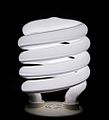Compact fluorescent lamp facts for kids
A compact fluorescent lamp (CFL) is a type of light bulb designed to fit into the same light sockets as older incandescent bulbs. CFLs are much more energy-efficient and last longer than traditional incandescent bulbs. They became very popular after the year 2000 because they save a lot of electricity.
Even though a CFL might cost more to buy at first, it can save you a lot of money on electricity bills over its lifetime. Some CFLs can save over US$30 in electricity costs compared to an incandescent bulb.
Contents
How Do CFLs Work?
Inside a CFL, there's a small amount of mercury vapor. When electricity flows through this vapor, it creates ultraviolet (UV) light. This UV light isn't visible to us. However, the inside of the bulb is coated with a special material called a phosphor. When the UV light hits the phosphor, it glows and produces the visible light we see.
Every fluorescent lamp needs a part called a ballast. The ballast controls the amount of electricity flowing through the bulb. This prevents too much electricity from going through and damaging the bulb. In most CFLs, this ballast is built right into the plastic base of the bulb. These are called "self-ballasted" lamps. Most modern CFLs use electronic ballasts.
How Long Do CFLs Last?
CFLs are known for lasting a long time. On average, a CFL can last 8 to 15 times longer than an old incandescent bulb. Most CFLs are designed to work for 6,000 to 15,000 hours. In comparison, incandescent bulbs usually only last about 750 to 1,000 hours.
The actual life of any light bulb can depend on several things. For example, how often you turn it on and off can affect its lifespan. If you switch a CFL on and off very frequently, like every few minutes, it might not last as long. Some experts suggest that if you're leaving a room for less than 15 minutes, it's better to leave the CFL on. This helps it last longer. There are also special "cold cathode" CFLs that are made to handle being turned on and off many times.
CFLs and Mercury: What You Need to Know
CFLs contain a very small amount of mercury inside the glass tube. This mercury is important for the bulb to produce light. The amount of mercury is usually smaller than the tip of a ballpoint pen.
During normal use, the mercury is safely sealed inside the bulb and cannot escape. However, if a CFL breaks, the mercury can be released. Because mercury is a toxic substance, it's important to handle broken CFLs carefully.
If a CFL breaks, it's a good idea to open windows to air out the room. Instead of using a vacuum cleaner, which can spread the mercury vapor, it's better to use duct tape to pick up the broken glass and any powder.
Because of the mercury content, CFLs should not be thrown in regular trash. They are considered hazardous waste and should be taken to a special recycling center. Recycling CFLs helps make sure the mercury is handled safely and doesn't harm the environment.
Other Light Bulb Choices
Besides CFLs, there are other types of light bulbs available today:
- Halogen bulbs: These bulbs are a type of incandescent bulb with a special halogen capsule inside. They don't contain mercury. They use more energy than CFLs but less than traditional incandescent bulbs.
- LED bulbs: LED bulbs are becoming very popular. They are also mercury-free and use about the same amount of energy as CFLs, or even less. They are known for being very long-lasting.
- High-intensity discharge (HID) bulbs: These include types like sodium-vapor and mercury-vapor lamps. They are often used for lighting large areas, like streetlights, because they produce a lot of light. Like CFLs, some HID bulbs also contain mercury.
Images for kids
-
Characteristic spectral power distributions (SPDs) for an incandescent lamp (left) and a CFL (right). The horizontal axes are in nanometers and the vertical axes show relative intensity in arbitrary units. Significant peaks of UV light are present for CFL even if not visible
-
A photograph of various lamps illustrates the effect of color temperature differences. From left to right: • Compact Fluorescent (General Electric, 13 W, 6500 K) • Incandescent (Sylvania, 60 W, Extra Soft White) • Compact Fluorescent (Bright Effects, 15 W, 2644 K • Compact Fluorescent (Sylvania, 14 W, 3000 K)
-
Voltage and current for a 120 V 60 Hz 30-watt compact fluorescent lamp. Because the current is heavily distorted, the power factor of this lamp is only 0.61. The lamp takes 29 watts, but 39 volt-amperes due to this distortion.
See also
 In Spanish: Lámpara fluorescente compacta para niños
In Spanish: Lámpara fluorescente compacta para niños











